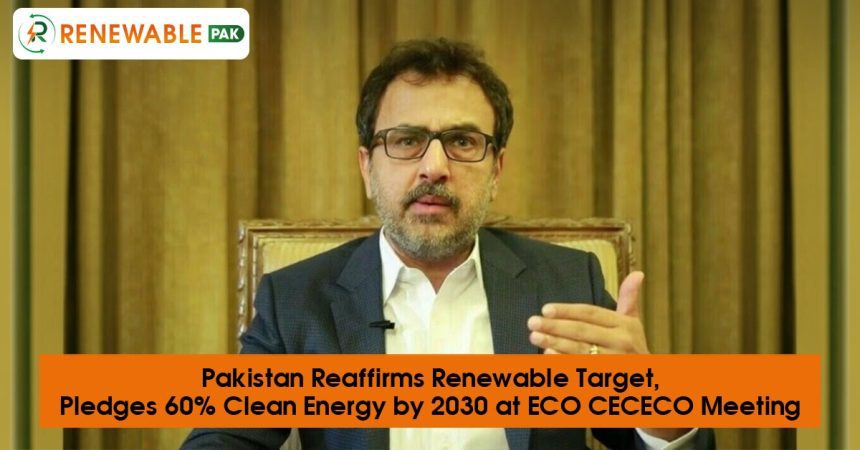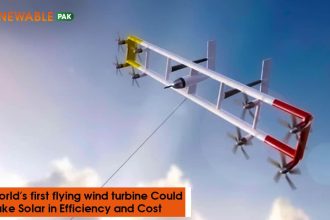Pakistan Renewable Target has been publicly reiterated as the country aims to achieve 60% of its power mix from clean energy sources by 2030. Sardar Awais Ahmad Khan Leghari, Federal Minister for Energy, made this commitment at the first Board of Governors meeting of the Clean Energy Centre (CECECO) under the Economic Cooperation Organisation (ECO). This declaration highlights Pakistan’s growing determination to combat climate change, ensure energy security, and foster regional collaboration in sustainable energy.
The Significance of the Pledge
- By 2030, Pakistan wants 60% of its total power mix to come from clean or renewable sources.
- Currently, renewable energy sources account for more than 42% of the nation’s grid-connected capacity.
- Additionally, clean energy sources accounted for more than half of the electricity generated last year.
- Although these figures show that Pakistan has made great strides, much more work is still required to meet the 60% goal in a few years.
Important Techniques for Reaching the Pakistan Renewable Target
1. Growing Renewable Production
Pakistan is increasing utility-scale renewable projects by utilizing its natural resources, which include hydro, wind, and solar.
- Through net metering, more than 5.8 gigawatts of solar energy have already been added to residences and commercial buildings.
- Clean energy technology is incorporated into the planning of the majority of future power expansion projects.
2. Decentralisation & Grid Modernisation
- In order to reach rural areas with restricted grid connectivity, microgrids and decentralised energy systems are being advocated.
- It is recognized that updating the current grid infrastructure to accommodate more sporadic clean energy sources (such as wind and solar) is a difficulty. Improvements to the grid must be funded.
3. Regulatory Structures and Private Sector Involvement
- To entice the private sector to participate in the development of clean energy, Pakistan has implemented regulations that are favorable to investors.
- In order to supplement the production of clean energy, energy efficiency initiatives are also prioritized.
4. CECECO-facilitated regional cooperation
Pakistan is taking part in the ECO Clean Energy Centre (CECECO), a regional organization created to help ECO member states coordinate their efforts. Among its functions are:
- Serving as a knowledge base for energy efficiency, data, statistics, and best practices.
- Promoting financial and technical collaboration for major projects that may be too difficult for one nation to manage on its own.
- Assembling financial and technical support for low-carbon projects.
The Significance of the Pakistan Renewable Target in Climate Change Mitigation
Making the transition to sustainable energy lowers greenhouse gas emissions, assisting Pakistan in fulfilling its obligations under international climate accords.
Cost reduction and energy security:
By diversifying into renewable energy, Pakistan minimizes dependence on imported fossil fuels, which are vulnerable to price swings. Once infrastructure is established, clean energy sources like wind and solar have lower operational costs.
Socioeconomic Advantages:
- Decentralized systems that electrify rural areas can raise living standards.
- Creation of jobs in the maintenance, infrastructure, and other industries of renewable energy.
- Decreased air pollution, which benefits public health.
Leadership in the Region
Pakistan sets an example for its neighbors in the ECO region by committing to 60% sustainable energy. Pakistan can increase regional energy resilience by exchanging experiences and learning from others through CECECO.
Obstacles to Surmount
Although the goal is admirable and ambitious, there are a number of obstacles that need to be overcome:
- Large-scale renewable infrastructure financing requires both international investment and domestic money.
- Grid stability: Sturdy grid systems and storage technologies are necessary when integrating intermittent sources like solar and wind.
- Policy coherence: To promote long-term investments, regulatory frameworks need to stay steady.
- Technological capacity: It is essential to establish capacity, transfer technology, and train the local workforce.
- Access for rural and isolated locations with poor grid access.
Leadership Quotations
Pakistan’s support for the regional clean energy effort was emphasized by Federal Minister for Energy Sardar Awais Ahmad Khan Leghari, who also said that the operationalization of CECECO was “timely and essential.” He clarified that the center would enable ECO member states to collaborate on shared issues, especially those pertaining to climate change, energy security, and sustainable economic growth. He claims that Pakistan views CECECO as a useful tool to pool resources, exchange knowledge, and hasten the region’s adoption of renewable technologies in addition to serving as a forum for discussion.

Leghari further emphasized that by utilizing the “region’s brightest minds,” the center’s technical committees and theme hubs would act as catalysts for innovation and provide solutions that were specific to the circumstances of the ECO nations. He pointed out that member nations may cut expenses, prevent effort duplication, and improve the overall resilience of their energy systems by combining their financial and intellectual resources. He contended that this cooperative model strengthens regional unity while positioning CECECO as a catalyst for reaching Pakistan renewable target energy aim of 60% clean energy by 2030.
Looking Ahead
Pakistan must concentrate on several interconnected areas in order to meet its set Pakistan renewable target. First, in order to monitor progress and uphold responsibility, a well-defined plan with quantifiable benchmarks between now and 2030 is necessary. Strong incentives for both domestic and foreign investors will be necessary to attract green investment, which will also be crucial.
In addition to creating jobs, bolstering domestic sectors to produce or assemble renewable energy components will lessen dependency on imports. In parallel, Pakistan will be able to strengthen its clean energy transition by investing in research and development, especially in fields like battery storage, smart grids, and hybrid systems. Finally, sustained public awareness campaigns and inclusive stakeholder engagement are critical to ensure that citizens, the private sector, and provincial governments remain aligned with the national clean energy vision.
Final Thoughts on Pakistan Renewable Target
Pakistan is demonstrating its strong commitment to energy autonomy, climate resilience, and sustainable development by reiterating its renewable objective of 60% clean energy in the power mix by 2030. At the ECO CECECO summit, Minister Leghari underlined that collaboration with surrounding states as well as inside the nation is necessary to accomplish this Pakistan renewable target. Pakistan stands to benefit from lower carbon emissions as well as long-term energy security, economic expansion, and leadership in the clean energy transition in the area if it can successfully negotiate financial, technical, and regulatory obstacles.
Read More about Solar Panel Price in Pakistan: All the Information You Need to know











